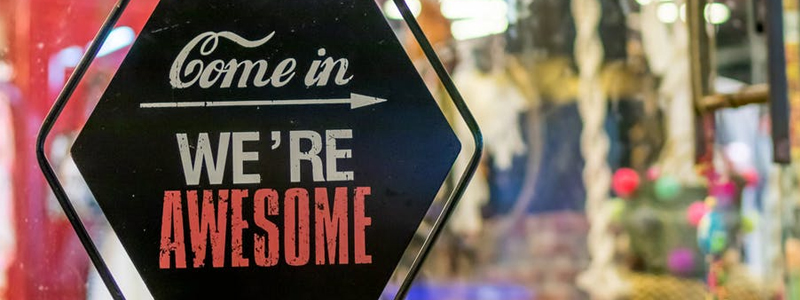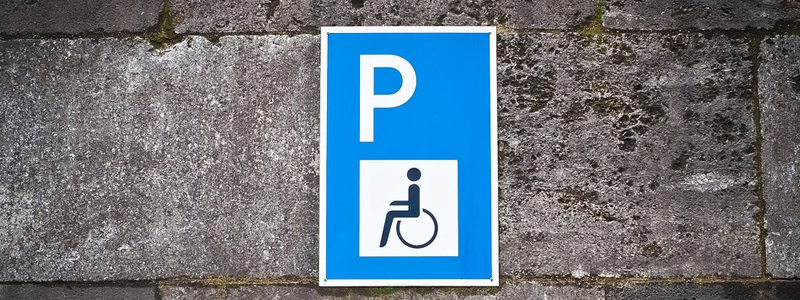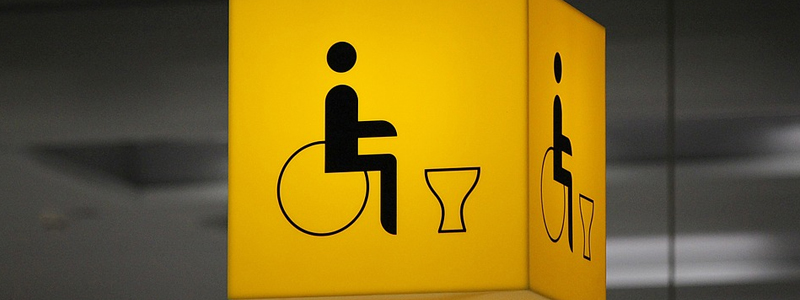
How to make your business accessible for customers
Every year we see an increase in the number of people living with some type of disability in the UK and with it, the economic value of these people also increases. The ‘purple pound’ as it’s also called is more valuable than ever and businesses that are willing to make small but significant adjustment to improve accessibility to their goods or services can expect to take home a slice of the pie. Unfortunately, despite the obvious benefits to businesses, not to mention the disabled population, many are still falling far short of even basic accessibility standards.
 Most accessibility solutions are affordable and easy to implement for the business and they can make a serious improvement to the everyday lives of disabled people. Making your business accessible gives disable people much-needed freedom to carry out everyday tasks independently which is not only vital practically but can also improve their overall well-being and happiness.
If you’re still not convinced, then consider the benefits directly to your business. Estimated at £249 billion last year businesses can reap some considerable profits by catering to the purple pound.
Most accessibility solutions are affordable and easy to implement for the business and they can make a serious improvement to the everyday lives of disabled people. Making your business accessible gives disable people much-needed freedom to carry out everyday tasks independently which is not only vital practically but can also improve their overall well-being and happiness.
If you’re still not convinced, then consider the benefits directly to your business. Estimated at £249 billion last year businesses can reap some considerable profits by catering to the purple pound.





 If there are obstructions that you can’t get rid of such as sharp corners, then do your best to highlight these hazards with signage and coloured warning tape to help people avoid potentially dangerous accidents.
If there are obstructions that you can’t get rid of such as sharp corners, then do your best to highlight these hazards with signage and coloured warning tape to help people avoid potentially dangerous accidents.




Why accessibility is so important
While The Equality Act 2010 means there are laws against discriminatory acts, improving accessibility is down to the individual business. Providing the most basic form of access such as ensuring someone can enter your business is a legal requirement, but additional equipment and considerations that could significantly help disabled people aren’t. Most accessibility solutions are affordable and easy to implement for the business and they can make a serious improvement to the everyday lives of disabled people. Making your business accessible gives disable people much-needed freedom to carry out everyday tasks independently which is not only vital practically but can also improve their overall well-being and happiness.
If you’re still not convinced, then consider the benefits directly to your business. Estimated at £249 billion last year businesses can reap some considerable profits by catering to the purple pound.
Most accessibility solutions are affordable and easy to implement for the business and they can make a serious improvement to the everyday lives of disabled people. Making your business accessible gives disable people much-needed freedom to carry out everyday tasks independently which is not only vital practically but can also improve their overall well-being and happiness.
If you’re still not convinced, then consider the benefits directly to your business. Estimated at £249 billion last year businesses can reap some considerable profits by catering to the purple pound.

What to consider when it comes to accessibility
Accessibility might bring to mind different things for different people. For people living with a visual impairment, accessibility means visual aids whereas many of us may think of ramps and handrails when we think about accessibility. To make your business truly accessible you’ll need to think about the various types of disability that you may need to cater for.Mobility
For disabilities that affect mobility, you’ll need to consider obstructions and space that might further hinder poor mobility. You should also consider what additional assistance you and your employees can provide to these customers.
Visual
Visual impairments can range from relatively mild to complete blindness, so you should again consider all aspects that will affect visual impairments. Again, this will include obstructions that could be an additional hindrance, as well as signage and other visual aids that may need to be adjusted.Audio
You may also find some people are hard-of-hearing or even completely deaf. Again, the range of audio impairment will vary so consider any audio aspects of your business that might not be suitable for these customers such as communication with employees.
Business accessibility best practices
Here are our top tips and best practices for making your business accessible to all customers. These tips cover audio, visual and mobility disabilities as well as some other general guidance. The great thing about these practices is most if not all are relatively affordable and easy to implement, plus many will be just as appreciated by people living without a disability as they simply make for a more welcoming environment.Parking
If you provide parking as part of your business operations you should make sure to mark one space as a disabled priority spot. If you have a small car park or just a couple of parking spots than you can put signage to indicate it should be considered a priority spot, so it may be used by those without a disability as well. Make it clear to customers on your website or with signs in your business that you can reserve the spot for people with a disability if they want to call ahead.
Entrance
Providing a warm welcome is a huge part of any business so your entryway is a vital first step in making your business accessible. Many people with a disability turn away at the first hurdle and you’ll miss out on valuable customers not to mention gain a reputation for not being accessible. Look at any obstructions such as steps or narrow doorways and provide a solution, whether it’s a permanent or temporary wheelchair ramp or finding a way to make more space at the entrance, for example installing double doors. You should also provide plenty of signs in the front of your business that customers can see from the street to promote your various accessibility benefits. Anything that you provide to make life easier for those with a disability should be clearly displayed to let people know that you put accessibility first.
Space
Ensuring that there is enough space for customers to easily get around is great for everyone, not just those with mobility or visual disabilities. Make sure aisles are clear and leave plenty of space between furniture, shelving or other items inside and make sure to look out for anything that seems to be blocking the way or negatively impacting the space. Remember that wheelchairs will want plenty of room to turn around; if you struggle with space then consider making a one-way system or some type of path to help people get around easier.Obstructions
As well as ensuring there is enough space around the floor areas you should also identify any other obstructions throughout the premises. Use a wheelchair to go around as there could be things you miss such as narrow corridors, doorways or small steps. Just like your entryway, look at temporary ramps for steps and obstacles and try to widen doorways where possible if they are especially narrow. If you can't improve structurally you may need to re-organise your layout to ensure wheelchair users can access everything they need without having to use these narrow areas. During business hours think about leaving doors open as heavy doors are often a key barrier for wheelchair users or those with a mobility issue and can be a problem for the visually impaired as well. If you can’t leave them open, then look at other ways to ensure they are easy to open such as using a lighter material or even installing an automated system if it’s practical. Similarly, if you have an upstairs area and you need to provide access to those with a disability then you may need to install some type of lift. If there are obstructions that you can’t get rid of such as sharp corners, then do your best to highlight these hazards with signage and coloured warning tape to help people avoid potentially dangerous accidents.
If there are obstructions that you can’t get rid of such as sharp corners, then do your best to highlight these hazards with signage and coloured warning tape to help people avoid potentially dangerous accidents.
Furniture
As well as the overall space don’t forget to think about how the furniture itself might be a problem for certain disabilities particularly for wheelchair users. Have a mixture of high and low tables so wheelchair users can use lower tables and remain in their chairs, and make sure chairs or other furniture is easy to move around as you may need to make room in certain areas at the last minute.Toilets
If you provide public toilet facilities in your business space, then it’s vital you ensure that you either have a separate disabled toilet or one toilet that can be used by people with a disability. You’ll need to make sure there is enough space for people to manoeuvre with wheelchairs or even with a carer as well as providing additional aids such as handrails and low sinks.
Signage
Signage is another aid that is useful for all customers, not just those with audio disabilities. Make sure you signpost important aspects of your business such as hazards, disabled toilets and any other assistance you can provide customers. For the signage itself be sure to use a 72-point sans-serif font like Verdana or Arial in a dark contrasting colour to the background to accommodate people with poorer vision, and we also recommend trying to provide Braille or raised letter signage for those that are blind. Where appropriate use images with your signs so people can also indicate with images. For example, pictures of the dishes on a menu.Lighting
While mood lighting is great for creating ambience, it can, unfortunately, make things difficult for those with poorer vision and people with mobility impairments. Try and think practically and make sure there is plenty of light for people to see where they’re going and read signs properly.
Noise
Again, background music can also be tempting for some businesses, but noise can be extremely off-putting for a wide range of disabilities including hearing impairments where it can be hard to distinguish different sounds. Try and limit background music as well as other background noise and experiment with the general acoustics to try and keep noise to a minimum. If you have TV screen or video in your business, you should use closed captioning for those who are hard-of-hearing or deaf which also has the added benefit of allowing you to keep the noise from the TV down.
Point of sale
The point of sale, whether it’s a reception area or checkout desk, is vital to your business and your customers. Often its where the main communication and customer service takes place. It’s therefore key that you make this area as welcoming and flexible as possible for various disabilities. Look at using a completely mobile or extended cord debit card machine and ensure the machine has Braille on the keypad for blind customers. For those that are hard of hearing you could get a hearing loop for the business especially at your reception or another point of sale area. A hearing loop or audio induction loop provides a magnetic, wireless signal that can be picked up by hearing aids set to the Telecoil (T) setting to help them hear better. Additional signs, such as pictures of the cards you accept, can help you communicate with deaf people.






